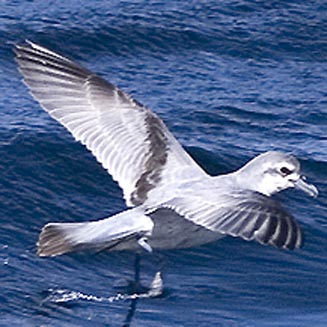|
Pachyptila turtur (Fairy prion)
SwartstertwalvisvoŽl [Afrikaans]; Duifprion [Dutch];
Prion colombe [French]; Feensturmvogel [German]; Painho-filtrador-de-cauda-preta
[Portuguese]
Life
> Eukaryotes >
Opisthokonta
> Metazoa (animals) >
Bilateria >
Deuterostomia > Chordata >
Craniata > Vertebrata (vertebrates) > Gnathostomata (jawed
vertebrates) > Teleostomi (teleost fish) > Osteichthyes (bony fish) > Class:
Sarcopterygii (lobe-finned
fish) > Stegocephalia (terrestrial
vertebrates) > Tetrapoda
(four-legged vertebrates) > Reptiliomorpha > Amniota >
Reptilia (reptiles) >
Romeriida > Diapsida > Archosauromorpha > Archosauria >
Dinosauria
(dinosaurs) > Saurischia > Theropoda (bipedal predatory dinosaurs) >
Coelurosauria > Maniraptora > Aves
(birds) > Order: Ciconiiformes
> Family: Procellariidae
 |
|
|
Fairy prion, offshore from New South Wales,
Australia. [photo Ryan Shaw ©] |
|
Distribution and habitat
Breeds at sub-Antarctic and south temperate islands in the
austral summer, as well as at south-west and central Indian Ocean and South-west
Pacific islands. It is a rare vagrant to southern Africa, with isolated records
of stranded birds between June-November along the coast, from KwaZulu-Natal to
southern Namibia.
Food
It mainly eats small crustaceans (especially amphipods and
euphausiids), supplemented with small fish and squid, doing most of its foraging
by grabbing prey from the water surface or occasionally diving to greater
depths.
Threats
Not threatened, with a world population of approximately
five million individuals.
References
-
Hockey PAR, Dean WRJ and Ryan PG 2005. Roberts
- Birds of southern Africa, VIIth ed. The Trustees of the John Voelcker
Bird Book Fund, Cape Town.
|
